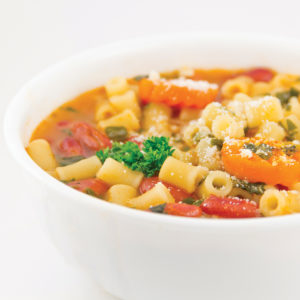
Whether you follow the Planetary Health Diet, the Mediterranean Diet or the updated Canada Food Guide, piling your plate with healthy, delicious food is only part of the story.
By Victoria Beechum
Nutrition has been making news this spring. With all the noise (and controversy) hitting the headlines, the question of how to choose a winning diet might seem more confusing than ever. Loyal readers know, when we say diet, we’re talking about how your food choices and eating habits add up to create a profile of how you eat. We never mean dieting for weight loss, because those kinds of diets: 1) don’t work, and 2) don’t promote a healthy relationship with food and nutrition.
That said, we’re going to make an exception to our diet avoidance for three trendy “diets” that are nutritionally sound and backed by science. These are the Planetary Health Diet, the Mediterranean Diet, and the updated Canada Food Guide. More than diets, they’re full-on lifestyle plans. We’ll go into the details in a minute, but here’s the big reveal: all three plans basically recommend the same dietary guidelines. Eat lots of fruits and vegetables, choose whole grains and unsaturated fats, and limit animal sources of protein. Move your body more and make meal planning and eating a social activity. Along the way, your choices may help save the planet!
Planetary Health Diet
This diet is the result of an international study whose 18 co-authors work in fields such as human health, agriculture, political science, and environmental sustainability, explains Amy Campbell, a dietitian at Deer Lodge Centre. It emphasizes a diet that is both “healthy for people and for the earth.”
The goals of the EAT-Lancet Commission that created the Planetary Health Diet are to convince 10 billion people to adopt it (or something similar) by 2050, to move towards globally sustainable agricultural practices, and to reduce food loss and waste by 50 per cent.
The recommendations for those wanting to put it into practice are:
- Eat to optimize health, defined broadly as being a state of complete physical, mental and social well-being, and not merely the absence of disease.
- Build a planetary health plate, which contains half a plate of vegetables and fruits, and half a plate of whole grains, plant protein sources, unsaturated plant oils (which are liquid at room temperature) and—optionally—modest amounts of animal protein.
The summary report was released in January 2019 and has since been compared to the Mediterranean Diet by almost everyone who has tried it.
Mediterranean Diet
The Mediterranean Diet is the product of a 50-year study pioneered by Ancel Keys, an American physiologist looking into why the rates of heart and vascular disease differed among certain countries, explains Campbell. “What he and his collaborators determined was that dietary patterns in the Mediterranean and Japan were associated with lower rates of heart disease, and, in fact, death from all causes.”
The Mediterranean Diet isn’t just about what goes onto your plate. It’s a whole health lifestyle plan that includes sufficient physical activity, non-smoking, and moderate (but optional!) alcohol consumption. “The study also provided evidence that the major risk factors for heart disease are universal and that heart disease is preventable,” adds Campbell.
The five basic tenets of the Mediterranean Diet are:
- Eat plenty of fresh and seasonal fruits and vegetables, dry-roasted nuts and seeds, legumes (eg. chickpeas, lentils), potatoes, whole grains including bread and pasta, local seafood, fresh herbs, and cold-pressed olive oil.
- Eat local eggs, poultry, fresh cheese and yogurt in moderation.
- Drink wine in moderation and with meals.
- Choose red meat occasionally.
- Eliminate added sugar and sugar-sweetened beverages, refined grains, processed meat, refined oils and other highly processed foods.
“An important part of this diet is to focus on a healthy lifestyle,” says Campbell. “Make time to enjoy cooking and sharing mealtime together with friends and family. Try to include three meals a day, aim for at least 30 minutes of physical activity each day, and get enough rest.”
If you’ve spent any time exploring the new Canada Food Guide, this is all going to sound very familiar.
(Updated) Canada Food Guide
Healthy eating is about more than the foods you eat, and the Canada Food Guide, updated this January, places an emphasis not just on the composition of your plate; it reminds people to be mindful and to enjoy themselves.
“That means making time to eat,” says Campbell. “It means noticing when you are hungry and when you are full, planning ahead, and cooking more often. As in the Mediterranean Diet, include friends and family in food preparations and meals.”
To get your lifestyle in line with the new Canada Food Guide:
- Make it a habit to eat a variety of healthy foods each day.
- Eat plenty of vegetables and fruits, whole grain foods and protein foods. Choose protein foods that come from plants more often.
- Choose foods with healthy fats instead of saturated fat (think: liquid at room temperature).
- Limit highly processed foods. If you choose these foods, eat them less often and in small amounts.
- Prepare meals and snacks using ingredients that have little to no added sodium, sugars or saturated fat. Eliminating processed foods will help with this goal.
- Choose healthier menu options when eating out.
- Make water your drink of choice, but especially replace sugary drinks with water.
Be aware that food marketing can influence your choices. Knowledge will help you make good decisions, so learn to read food labels! If you need guidance read-ing food labels, advice about the difference between diet marketing and sound nutrition, or any other nutrition questions, contact Dial-a-Dietitian. They can be reached in English and French, weekdays at 204-788-8248 in Winnipeg, 1-877-830-2892 in Manitoba.

Everyone’s favorite Italian bean soup, pasta Fagioli
Recipe
Pasta e Fagioli
By Francy Pillo-Blocka
Ingredients:
1 tbsp olive oil
6 cloves garlic, minced
1 large tomato, chopped
1 can (19 oz) white kidney beans, drained and rinsed, divided
1 can (19 oz) chickpeas, drained and rinsed, divided
3 cups vegetable broth
1 cup dry white wine
3 cups elbow pasta (or similar)
2 tbsp chopped fresh parsley
Instructions:
- In a large pot, heat oil over medium heat, Sauté garlic for 1 to 2 minutes or until softened but not browned. Add tomato and sauté for 1 to 2 minutes or until starting to soften. Add half each of the white kidney beans and chickpeas; mash with a potato masher and stir to combine.
- Stir in broth, wine and the remaining kidney beans and chickpeas; bring to a boil. Reduce heat and boil gently for 8 to 10 minutes or until pasta is al dente. Stir in parsley.
- Serve and enjoy!
Francy Pillo-Blocka RD FDC is a Registered Dietitian
Recent News

Embracing Hope: The Impact of DLC’s Movement Disorder Clinic

Winnipeg Jets Parkinson’s Disease Awareness Game!

